"I am become Death, The Destroyer Of Worlds" - J Robert Oppenheimer
++++++++++++++++++++++++++++++++++++++++++++++++++
I decided to postpone the article I was planning for this month to look at some Cold War films about dropping the atomic bomb because...oh no reason. It's not like a possible World War Three is something that might suddenly be relevant or anything. Sigh.
BILL HALEY & THE COMETS ~ "13 WOMEN";
Post nuclear apocalypse docudrama films were a genre that basically peaked in the 1980's with the high profile made-for-TV movies "Testament" (1983), "The Day After" (1983), "Threads" (1984) and the classic animated film "When The Wind Blows" (1986). Ironically within a few years of the end of the decade the Cold War was declared over and such doom-scrolling movies were considered relics of an already bygone era. Note; I am speaking here purely of movies which purported to be fact based (or reasonably so) docudramas about nuclear war, not post-apocalypse fantasies like "The Road Warrior", "The Road", "The Postman" or the "Book Of Ella".
For this survey we shall look at some films of the early 1950's & 60's Cold War era (thus B&W), setting aside the rash of made-for TV movies of the 70's and 80's such as those listed above. We will also limit ourselves to those presented as docudramas or reasonably realistic thrillers rather than Sci-Fi films or Fantasy such as "The Last Man Alive" (with Vincent Price, later remade as "I Am Legend"), political thrillers like "Failsafe" (w/Henry Fonda), B-Movie Creature Features like "The Day The World Ended" (directed by Roger Corman) or parodies like "Dr Strangelove" nor will we bother with the sort of dry informational or how-to-survive-the-bomb shorts put out by various governments such as the classic "Duck & Cover".
Oh, What the Hell. I know what you want;
"DUCK & COVER" (1951);
This is without question the most famous government made ad of all time. Directed by Anthony Rizzo, an otherwise obscure TV producer with only one other similar short to his name. Rizzo (1918-2004) was an Italian immigrant who had trained as an opera singer and actor before enlisting in the US Army during WW2 where he served as a radio operator. After the war he made his way to the fledgling television industry where in 1949-50 he worked as a producer on "Majority Rules", a game show hosted by future newsman Mike Wallace before joining Archer productions, a major advertising firm making TV commercials. Besides an unknown number of TV ads and corporate promo films he would make two films for the Department Of Defence. "Duck & Cover" is not notably different from other public instructional films of the era in terms of its information, but it does move briskly and has some catchy Madison Ave ad copy writing. The most notable features of the film which makes it stand out from other government films are its catchy slogan/musical theme which it repeats several times and the animated character Bert The Turtle. The animation was done by Emery Hawkins who had a long career working on Looney Tunes and Tom & Jerry cartoons and it has the instantly recognizable style of the classic cartoons of the era. Rizzo also made another A Bomb film "Our Cities Must Fight" in 1951.
"OUR CITIES MUST FIGHT" (1951);
This film lacks entirely the charm and light touch of "Duck & Cover" instead being a pedestrian corporate promo type short with a couple of drab talking heads reading simplistic lines in a would-be casual manner. It doesn't help that the main character is a smug know-it-all but what's worse is the cold-bloodedly delusional message of the film which is that civilians in bombed out cities should stay in the radioactive rubble and get back to work. At least "Duck & Cover" gave people advice on how to protect themselves, however inadequate, this film openly tells the general public they are in effect little more than disposable cannon-fodder. Little wonder this film is not as fondly remembered. As for Anthony Rizzo, he made no other notable films returning to faceless and forgotten TV ads and corporate promos while moonlighting at his first love of acting in amateur theatre. He retired from advertising in the seventies to try his hand in real estate dying in 2004, the same year his iconic short was listed in the National Film Registry as being "Culturally and Historically Important", high praise for a quickie informational short he probably assumed was just another advertising gig that would be quickly forgotten like the rest of his canon.
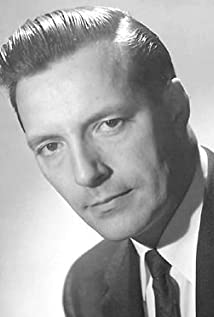
ANTHONY RIZZO
+++++++++++++++++++++++++++++++++
"THE FIVE" trailer (1951);
The first post atomic bomb film is generally believed to be "Five" (1951) written by Arch Oboler. The plot has a group of five survivors living in an abandoned resort house in the hills outside an unknown city (presumably in California) in which all life has been wiped out after a nuclear war. The survivors include a man from the city (Michael), a pregnant woman (Roseanne) whose husband is missing, a bank manager and his black bank guard (Charles) and a German former military officer (Eric). There are no other known survivors on the planet. They arrive one by one and do not know each other but must cooporate to survive. The man, woman and bank guard manage to find ways to work together, repairing the house, building more cabins and furniture, finding a generator and starting a garden. However the elderly bank manager dies from radiation sickness. The German officer turns out to be a racist martinet who expects the others to follow his orders. He refuses to do any chores and wants to find the nearest city to raid it for supplies and search for survivors but Michael and Charles refuse saying there is too much radiation. Roseanne gives birth to a boy which she refuses to name, she still wants to find her missing husband in the city who she believes is still alive. After a fight when Eric destroys the garden he decides to steal the jeep they have been using and go to the city, he talks Roseanne into going with him. While preparing to leave he is spotted by Charles who he kills. Not knowing this Roseanne leaves with him taking her baby. Michael wakes but finds Roseanne missing and Charles dead, She left him a note explaining she and Eric are going to the city so he sets out on foot after them. Reaching the city Eric and Roseanne find it full of skeletons and empty buildings and cars. She leaves Eric and finds her husband's body in his office. Meanwhile Eric has been robbing a jewelry store. When she returns and asks to return to their new home the jeep won't start and he announces he will never return or let her go. She attempts to flee but he grabs her as they struggle his shirt is torn revealing the same radiation burns the old man had before he died. Eric fless into the city in a panic and Roseanne walks away. On the hike home her baby dies and she buries it. Michael finds her and they return to the home where they will try to start over.

The story is more about a group surviving under stress rather than specifically about nuclear war with film critic Bosley Crowther noting that it could easily be about any group of castaways, however this neglects that the issue of world wide destruction and radiation poisoning adds an additional layer of hopelessness, castaways can at least hope for and perhaps work towards rescue while these characters can not. The plot has obvious similarities to William Golding's "Lord Of The Flies" with it's theme of an isolated society breaking down under stress however that novel was not written until 1954. Making the story post nuclear allows for some disturbing issues and they notice that there don't seem to be any animals left alive aside from some circling vultures. While the two main characters survive and resolve to struggle on and the possibility of other survivors somewhere is raised the future looks grim. Unlike some other films and TV show we will see there is no mention of a surviving government or other groups that can rebuild society at large. The film's limited budget means that we see little actual damage. The film starts by portraying the war by simply showing some stills and stock footage of various cities with smoke superimposed over them. When we get to the city all the streets and buildings have been abandoned but there is no actual damage, Instead we see several skeletons lying about (they clearly decayed very quickly) which actually looks pretty creepy.While we are told that the radiation has killed off all the other people and animals the numerous trees and vegetation are somehow unaffected and they even grow a garden.

ARCH OBOLER
Arch Oboler who wrote, directed and produced, was a well known figure in radio dramas in radio's Golden Age of the 1930's and 40's as a writer and producer of radio plays dealing with science fiction, mystery and the supernatural with the successful series "Lights Out" which he also brought to TV in the very early era of the late 1940's early 1950's being the first such anthology series. He was a strong influence on Rod Serling and "Twilight Zone" and later Stephen King. He made this film independently on a small budget (the abandoned resort where much of the story is set and which looks like a Frank Lloyd Wright design was in fact Oboler's own vacation cottage and was indeed built by Wright) then selling it to a distributor where it was fairly successful. Although he did not have another TV series again after "Lights Out" he would continue writing and producing episodes for radio and TV as well as writing novels and short stories and even branching into Broadway through the sixties. He died in 1987 aged 77. The Frank Lloyd Wright home used as a set was destroyed by fire in 2016.
++++++++++++++++++++++++++++++++++++
Most of the early A-Bomb docudramas would be made for television with all the limitations of the first generation live TV and unlike "Five" would be made with in conjuction with the Civil Defense Dept and would include a government approved theme of preparedness to survive a nuclear attack and the message that it was possible to do so.
"ATOMIC ATTACK" (1954);
CAST;
Phyllis Thaxter ~ Gladys Maxwell
Patsy Bruder ~ Barbara Maxwell
Robert Keith ~ Dr Garson Lee
Walter Mathau ~ Dr Spinelli
Patty McCormack ~ Ginny Maxwell
PLOT (Spoiler Alert); The Maxwells are a normal family with two young daughters living in an unnamed town in upstate New York about fifty miles from New York City. One morning when as the husband commutes to work in the big city war begins with atomic bombs being dropped on the big cities including New York. The rest of the story shows the family dealing with the aftermath as the father never returns, the family shelter from nuclear fallout and other survivors are quartered in their house by Civil Defence. Outside there are occasional looters who are scared off by the family's shotgun. Worried about fallout Barbara (Patty McCormack), the teenage daughter's science teacher, Mr Garson (Robert Lee) visits to do radiation checks. He had previously worked on the Manhattan Project and has been avoiding the public worried he will be blamed for the bomb and destruction. The family agrees to let him hide out in their basement. The family is informed the father was in New York when the bombs fell and was killed. The missing husband of one of the borders also is reported as a survivor. Radiation begins to affect people as one of the female boarders is taken away with radiation sickness and the younger daughter Ginny gets sick as well as does Dr Garson. The story ends on a somewhat hopeful note as we are assured that Ginny's radiation sickness can be cured and the war is about to be won.

PATTY McCORMACK & WALTER MATHAU
This one hour drama was from "Motorola Presents" one of many anthology series common to TV in the first era of the late forties and early fifties. Like similar shows of the time, of every genre, it's highly stage-bound showing it's small budget and very short shooting schedule (it was probably largely shot live in a couple of takes) as well as the writer's likely roots in radio. This means having all action happening off stage with the nuclear blast being shown with air-raid sirens, an explosion sound and some shaking camera and a little falling ceiling debris. To be fair the show does state that the blast targeted big cities far away. This also leads to a strange quality where the family's comfortably furnished suburban home remains completely unchanged without so much as a broken window as do the mother and daughter's outfits of nice summer dresses, polished saddle shoes and perfectly coiffed hair. Everybody is also freshly scrubbed so clearly the water has not been cut off or been contaminated somehow. They did manage to resist the urge to have the Mother (Phyllis Thaxter) wear the typical TV Mom's pearl necklace although she and the teenage daughter do wear earrings throughout. Their refugee borders do wear pearls though and the elderly male boarder wears a suit and tie the whole time. The entire war takes place as radio bulletins from afar. Although various characters are affected by radiation and others die, all unpleasant action takes place off screen and since the show basically has one set the characters leave their home only once (a trip to the hospital near the end), indeed they rarely leave the living room or kitchen. This is the most antiseptic nuclear apocalypse show ever. Again to be fair all of this was quite common with TV dramas of the time being shot that way and it's also worth remembering that at the time this made in 1950 the threat was still the A-Bomb dropped by planes as at Hiroshima, not the H-Bomb delivered by ICBM's which would have made any such war at the time still essentially conventional for those not actually bombed. Thus the attitude of stiff-upper-lip everybody knuckle-down and do their part as if this would be just like the London Blitz while still wildly unrealistic was not quite as blithely delusional as it seems now. Still the basic message of the film (endorsed by every government of the time) that an atomic exchange would be survivable without undergoing a mass death, a complete breakdown of society and permanant enviromental collapse has dated as well as the Suzi Homemaker fashions.
It's those fashions that really reveals the show's other larger agenda; The reinforcement of the traditional woman's role of homemaker. Notably the center of the story are the women. The husband leaves for work in the beginning and never returns. Thereafter the mother takes charge and holds the family together, when two other refugee women, one with two children in tow, are quartered with the family she takes care of them too without complaint. She does so not by adopting traditional male duties but by doggedly returning to her homemaking duties. While she is temporarily struck by the news of her husband's death she quickly rallies with the words "Well; Back to the kitchen". When the teenage daughter, who starts the story weeping and hysterical, steadies herself and becomes more mature she does so in the context of helping her mother "From now on I'll see to the children ''. The one time it becomes necessary to fire a gun at looters it is done (reluctantly) by a man, the visiting teacher Dr Garson Lee. There are men in the story but they are either authority figures (the two doctors and the block warden) or elderly (the retired border) and the offscreen radio announcers and neighborhood watch patrols, except for the faceless looters. The women do not challenge or even question the authority of the male authority figures but by maintaining traditional roles they are the ones who maintain the homefront while the men stroll in and out tending to administration, security etc. This theme would later be updated (if not subverted) in a more gloomy and fatalistic fashion in the 1983 movie "Testament" (with Jane Alexander). The story comes from a novel with the revealing title "Shadow On The Hearth" by American writer Judith Merril with its title showing its focus on the home and family rather than any larger societal impact. The book was her first and was an immediate success as one of the first to deal with a post atomic bomb in a way that was not sensational although Merril complained that the publisher had forced her to change the ending to be more upbeat. One change in the novel to the screen was in its location. While the show doesn't actually give the town a name other than saying it's within fifty miles of New York City in the novel it is named as Westchester, a wealthy suburb. Merril, then married to Sci-Fi writer Fredrick Pohl, would go on to a respected career as a Sci-Fi writer dying in 1997.
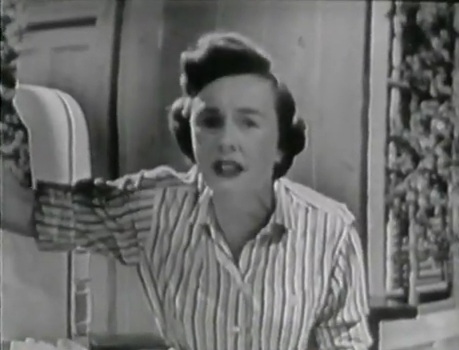
PHYLLIS THAXTER
As a trivia note Phyllis Thaxter, who plays the mother had appeared in the WW2 war film "30 Seconds Over Tokyo" about the Doolittle bombing raid (as one of the crew's wives natch), she died in 2012 aged 92. Dr Carson Lee was played by Robert Keith, the father of actor Brian Keith and who also starred in "Guys & Dolls". Teen daughter Barabra was played by Patricia Bruder who would become a soap opera regular for forty years while Patty McCormack as younger daughter Ginny, would be nominated for an Oscar in 1957 for "The Bad Seed" and continues to act as of this writing. The show also stars a young Walter Mathau (as a doctor), to the extent that Walter Mathau was ever young.
The limited home based focus of the Merril novel had the bonus of being easy to stage given the limitations of the early TV era but another early TV series portrayed the aftermath of an A-Bomb however in more grimly realistic terms.
+++++++++++++++++++++++++++++++++++++++++++
"THE MEDIC; A FLASH OF DARKNESS" (1955);
"The Medic" was in fact a regular series starring Richard Boone as an ER doctor at a hospital in Los Angeles, this was a special episode actually done with input from the Defence Department to give a more realistic version of of the aftermath of an Atomic Bomb drop on a major city and it's impact on emergency services. The show opens with the man character Dr Styner (Boone) being told to repare for an emergency drill which quickly turns out to be the real thing as an actual A-Bomb attack begins on the city. Dr Styner and his pair of nurses quickly set up an emergency hospital in a bombed out school to deal with the rush of casualties who arrive badly injured, burned and affected with radiation sickness. Over the course of two days over a thousand patients come through, many die. On the second day Dr Styner and his team are relieved and he will be reunited with his wife who he is informed is alive.
At only a half hour long there is not much story and less dialogue than the "Atomic Attack" but this episode is much more realistic and bleak. Gone are the Suzi Homemaker dresses and perfect hair. Instead everybody is quickly covered in soot and blood, looking exhausted and grim. In the previous show radiation poisoning is mentioned but any unpleasantness happens safely off screen here victims are shown with gruesome burns and one, a small boy suffers blindness and dies (albeit offscreen). As with the previous show most of the action takes place indoors in the makeshift hospital aside from a scene on the road (almost certainly shot on the indoor set) which is completely black and windswept. Again the radio announces the news from outside (voiced by actual veteran newsman Chet Huntley) but it is made clear that the city is utterly destroyed with the ground being too contaminated to bury the dead. Biological weapons are also mentioned as having been used. The handful of easily scared off looters from the previous show are replaced by news of mobs of violent rioters who must be brought under control by force as part of a larger partial societal breakdown. Instead of the stiff-upper-lip Spirit Of the Blitz speeches and attitude of the previous there is only a grim, weary determination but no real hysterics if only because everybody seems too shocked and tired to throw a fit. Once again the radio announces the ultimate likely victory in the war but this makes little difference to the characters who are too worn out to really care. When at the end Dr Styner attempts to give a reassuring speech it is done without conviction as if even he doesn't really believe it. As the story fades out we are left only with the cold sounds of a howling wind and the sound of more sirens. Clearly this is a far more harsh view of nuclear war than the previous entry or the numerous promotional shorts put out by the government or the TV networks and it's a little surprising that this episode was actually done with the Defense Dept's co-operation. This is the first drama to take a fairly realistic (if limited) view of nuclear war and it does a good job within the very real limits of it's budget and brief running time.

RICHARD BOONE
"The Medic" was a TV series that only lasted two seasons and was never a ratings hit but was praised by critics and medical professionals for it's gritty realism which is probably why the writers chose to do such a unique experiment of taking their regular show and characters and placing them into a different timeline apart from their usual stories as well as why the authorities trusted them enough to OK the project and associate themselves with it. Richard Boone was himself a veteran of WW2 which he returned from being heavily affected by what he had seen and his experiences may also have influenced the downbeat tone of the show. Boone was a craggy-faced, morose man with a chronic drinking problem as being a heavy chain smoker. A descendant of frontiersman Daniel Boone, he was nsturally primarily known for westerns, he would star in the popular, Emmy winning TV western "Have Gun Will Travel" (1957-63), appeared with John Wayne, including in his last film "The Shootist" (1976), starred as the TV western crimefighter "Hec Ramsey" (1972-74), as well as providing the voice of the dragon Smaug in the animated version of "The Hobbit" (1977) and turning down the lead role in "Hawaii 5-0" that went to Jack Lord. His lifetime of heavy smoking caught up with him when he was diagnosed with throat cancer in 1981. Informed he would have to quit smoking and drinking and undergo surgery he refused and went home to die. He was 63.
+++++++++++++++++++++++++++++++++++++++++
"A DAY CALLED X" (1957);
This was another TV special made by CBS in conjunction with the Defense Department. The plot runs down the preparations for an impending attack on Portland, Oregon and the preparations the local and federal governments have made. The city is quickly evacuated and local officials take shelter in a huge bunker complex to manage emergency and relief efforts. Everybody from officials to civilians, even school children are calm and professional. There is no panic or rioting. Everything runs according to careful planning and drills. The show ends with everyone waiting to see if the bomb actually drops with the assurance that everything has been prepared like clockwork. This time instead of featuring a few fictional characters the focus is on real live citizens and officials playing themselves (some of the civilians, like the dutiful mother and freckle-faced newspaper boy, are so perfectly cast and at ease on camera they may in fact be actors) including the Mayor Terry Schrunk. There is also a narration from actor Glenn Ford. Unlike the previous shows which were film on closed indoor TV studio sets, this show has plenty of outside scenes gorgeously shot, including an excellent opening scene, shot with a bird's eye, as a motorcade speeds up to the Civil Defence bunker. It is this last feature that makes the show so watchable today with plenty of great shots of 1950's Portland. The fast, no nonsense pace is also an asset. The brief half hour duration leaves little time for character developement and since the show ends before the actual bomb drop we do not learn their fate but we are assured everything is taken care of. The film's message of preparedness is essential but panic is unnecessary is noticeably more upbeat that the grim determination of the previous efforts and has been accused of fostering a false belief that a nuclear war is survivable as long as proper preparations are made. crucially these preparations are to be made by the entire society under government leadership. Unlike other, later post bomb films there is no hint of anybody holing up with their own guns and supplies, rioting, looting or societal breakdown.
Portland Mayor Terry Schrunk was quite a character himself. Elected in 1957 and in office until 1973, the longest serving mayor of the post war era. In spite of the squeaky clean wholesome image portrayed in the film Portland was known as wide open town with plenty of gambling, booze cans and brothels and Schrunk, a Democrat, was elected with support of unions including both the longshoremen (led by the openly communist Harry Bridges) and Jimmy Hoffa's Teamsters, with their mafia ties. This brought him into conflict with national Democrats including the Kennedys and got him investigated by the Senate Committee on Organized Crime in 1957 (along with Hoffa) which tried and failed to have him indicted with Bobby Kennedy testifying against him. The Mayor, with a good record of urban renewal and public works retained his popularity and continued to be reelected. A decade later when Bobby ran for the Presidential nomination Schrunk came out against him and Kennedy lost Oregon to Gene McCarthy in his first major defeat. Schrunk continued in office until a heart-attack forced his retirement in 1973 and he died two years later. He was only 61 and there's a good chance he probably could have otherwise stayed in office til the eighties.
++++++++++++++++++++++++++++++++++++++++++++++
"TARGET AUSTIN TEXAS" (1960);
This is another project done in collaboration with Civil Defense authorities and is somewhat similar to "A Day Called X" showing a city preparing for an impending bomb drop. However while "A Day Called X" shows a detailed account of the preparations but stops short of the acual bombing this film takes up where the previous one left off. The bomb drops and people huddle in shelters waiting for the fallout to disperse. However unlike in Portland where everybody followed protocols without complaint this time there is some panic, there are traffic jams, one woman complains about being in shelter and one man disregards instructions and attempts to flee the city. The lesson taken from the previous films to be prepared and follow instructions remains though as the complaining woman gets a hold of herself and pitches in to help organize supplies and survives along with all those who also made preparations and take shelter while the man who fled dies alone of radiation poisoning. Since the bomb doesn't actually hit Austin, title notwithstanding, there is no actual damage, instead we get some fairly eerie shots of abandoned streets and offices. Both films rely on a narrator with this one having little actual dialogue. Another notable difference is the tone, particularly with the music which is rather dramatic (including a snippet from the "William Tell Overture"). The cinematography however lacks the beauty of "A Day Called X" and Austin is just not as scenic as Portland. Note that in one shot can clearly be seen the University Tower where in 1966 Charles Whitman would go on an infamous shooting spree.
Where "A Day Called X" used local citizens and officials this film has an actual cast. However most are completely obscure and probably recruited from local amateur theatrical groups and local TV and radio stations. The film was the work of Cactus Pryor, an award winning Austin TV and radio reporter who wrote the script and also provided the narration and presumably appears as well. He would also appear in small roles in a couple of John Wayne's pro-war films "The Hell Fighters" and "The Green Berets". Another cast member is Charles Lasater with a minor actor of that name appearing in another 1960's war movie, the low budget "None But The Brave" (1966), presumably they are the same person. Yet another name is Bob Gooding with an actor or musician of that name appearing in a small role in a 1944 musical "Swing Hostess" starring singer Martha Tilton and who may or may not be the same person. The rest have no other credits.
++++++++++++++++++++++++++++++++++++++
"THE WORLD THE FLESH & THE DEVIL" (1959);
This was the first proper proper Hollywood production with a big name cast in Harry Belefonte, Inger Strevens and Mel Ferrer. Belefonte plays a sewer worker who is caught underground after an unexplained cave in only to discover once he digs himself out that the bomb has dropped and everybody has fled from the speading radiation leaving Belefonte and Stevens (who soon discovers him) as the only survivors in the deserted city. New York may be a ghost town but as in 'Five" and "On The Beach" it is oddly untouched by any blast damage, instead everybody has fled the city or died due to radiation poisoning (there are no bodies to be seen), leading to many great shots of the canyons of empty towers and streets jammed with abandoned vintage cars. As in "Five" and "Atomic Attack" just because civilization has broken down doesn't mean people aren't still going to keep up appearances with Inger wearing fashionable dresses and coiffed hair while the men, when not wearing jackets and ties, are neat and clean shaven. The Belefonte character is an engineering wiz who is able to whip up a functioning generator allowing full lights and power along with a shortwave radio and (less credibly) phone line between his apartment and Inger's allowing them to live lives that are not only normal but downright luxurious. There are a few radio messages from the outside world to indicate there are other survivors far away. The scenes of Belefonte roaming alone through the cavernous city show an obvious influence on the later film "I Am Legend '' along with having Belefonte sending out a daily shortwave radio broadcast for any other survivors. At this point the movie isn't really about a post nuclear world anymore anyway but about a lonely interacial couple figuring out how to live together, they could just as easily be castaways. Eventually another survivor appears (Mel Ferrer) leading to a competition over Inger. The film has several speeches debating racial politics of the era including the issue of inter-racial couples which no doubt seemed daring a the time and adding Ferrer to the mix is supposed to bring these issues to a boil and it does but the racial politics subplot that the movie has spent the first half setting up are quickly dismissed by having Ferrer assure us that he has no such problem to which Belefonte quickly agrees. Their rivalry is merely over Inger's favours. Having set up a premise and conflict the movie constantly undercuts its own message by having Belefonte and Ferrer repeatedly state how much they respect each other only to have Ferrer quickly become violent and stalking Belefonte through the deserted streets with a rifle. Presumably the writers felt that making Ferrer overtly racist would make him too much of a villain and would take the tension out of the choice faced by Inger. But having him become suddenly violent has already done that as has made Belefonte almost absurdly perfect. He's not only handsome and charming he's talented (he even gets to sing a few songs), is a mechanical genius and has almost superhuman patience and understanding while Ferrer is overbearing from the start. Inger should have no problem making a choice. The movie ends on a hopeful note as the trio head off to live happily ever after presumably into some sort of group marriage which doesn't really jibe with the previous gunplay. In the end the film is not as intelligent and meaningful as it thinks it is, doesn't have the courage to deal with the issues it raises and basically seems like an extended episode of "Twilight Zone" albeit with some alluring cinematography and fine performances from the charismatic Belefonte and the charming Inger Stevens.

The story was taken from a couple of novels with the title coming from a silent film which had an entirely different plot. By the time of filming Belefonte was a major star both as a singer and actor as well as being a civil rights figure and Mel Ferrer had a decade's worth of film credits while Inger Stevens was just starting her career. Born in Sweden and raised in Kansas City, Stevens was a tall willowy blonde with china doll features and soulful eyes. She would go on to star in a briefly successful if largely forgotten sitcom "Farmer's Daughter" for which she won an Emmy but is best remembered today for starring in two classic episodes of "Twilight Zone" both also in 1960. In "The Lateness Of Hour" she plays a woman who fears she may be a robot while in "The Hitch-Hiker" she plays a woman driving across the country who keeps meeting Mr Death over and over again. Later she would star as another tragic figure as a widow in "Hang Em High" with Clint Eastwood. Her real life also became associated with tragedy. Coming from a disposed background, largely abandoned by her parents, she ran away as a teen to become a burlesque dancer then an actor. Although she found quick success her personal life was a shambles. Personally shy, lonely and suffering from depression (qualities that seemed to come out in her roles) she would have two failed marriages (one to her agent) and have numerous affairs with unsuitable co-stars including Belefonte, Bing Crosby, Burt Reynolds, James Mason, Anthony Quinn and Dean Martin. Seemingly cursed she dodged death in two traffic accidents, a suicide attempt and even narrowly avoided a plane crash. She often talked in interviews about being lonely and unhappy even while successful. In 1970 another suicide attempt finally succeeded and she overdosed at the age of 35. At the time of her death she had been cast as the lead, against type, as a spy in a TV thriller "Most Deadly Game" with her role then going to Yvette Mimeux (the resulting series only lasted a season). Ironically given the issue of inter-racial couples raised in this film after her death it was revealed she had been secretly married to black actor Ike Jones since 1961, a fact that had been completely hidden from the public and most of Hollywood although they had been estranged at the time and she died alone.
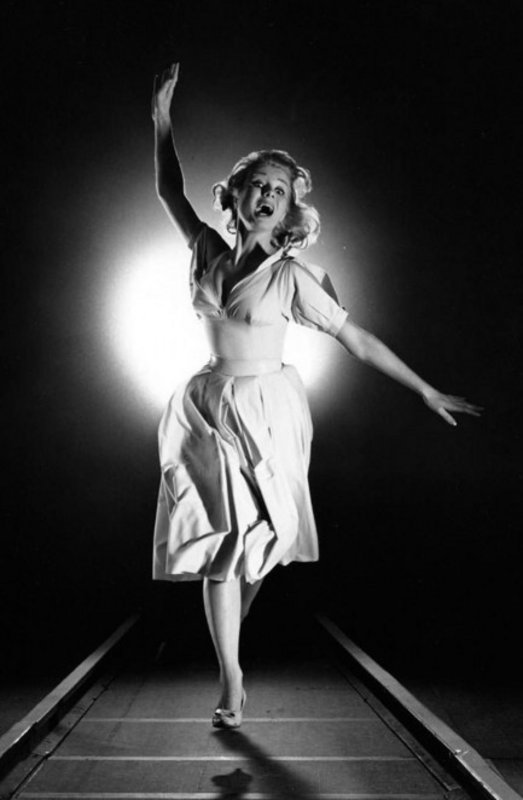
INGER STEVENS
+++++++++++++++++++++++++++++++++++++++
Speaking of "Twilight Zone";
"THE TWILIGHT ZONE" (1959-1964);
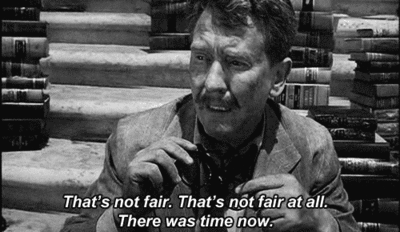
Rod Serling, heavily influenced by Arch Oboler, always intended to use the "Twilight Zone" and it's genres of Sci-Fi and Fantasy as vehicles to address social issues including war which led to some classic episodes. "The Shelter" was about a family that goes through the trouble to build a bomb shelter only to have the neighbours become violent trying to get in and was essentially the same theme as "The Monsters On Maple Street" although that story wasn't about a post nuclear disaster. Serling was both a humanist deeply concerned about injustice as well as rather cynical about human nature and in both stories people do not react calmly and carefully follow instructions from authorities (who are a distant presence), they instead panic and are quickly at each other's throats. Slighty more optimistically "Two" featured a young Charles Bronson and Elizabeth Montgomery as the last surviving two warring soldiers in a bombed out city who discover they need to put aside national hatred and live together. Note in this story we are never told what countries they are from, Montgomery, whose character speaks no English, is clearly meant to be Russian but Bronson, whose accent could never be confused for anything other than American, is wearing a finely tailored uniform that looks oddly Eastern European. The intent was probably to make him seem vaguely futuristic but he ends up looking like a turn of the century Hungarian guardsman. Serling wasn't always looking to make a political point however, sometimes he just enjoyed a twist ending of the O. Henry and Ambrose Bierce type as with one of the most iconic episodes. "All The Time In The World" featured Burgess Merideth as a mousy, bookish, nearsighted bank clerk who is saved when the bomb is dropped by being in the bank vault which is perhaps not coincidentaly the same thing that happened to two characters in Arch Oboler's "Five". Merideth, who is constantly bullied by his shrewish wife and smuggly officious boss for his obsessive love of books, emerges to find the city in ruins and everybody gone. After briefly feeling sorry for himself being alone he quickly decides he will now finally have time to read the entire library only to have his reverie shattered, literally. The character and his fate are rather ambivalent as while on the one hand it's hard not to feel sorry for the hapless little nerd ("Now that's not fair", he plaintively whines) it is worth noting that he doesn't actually miss us.
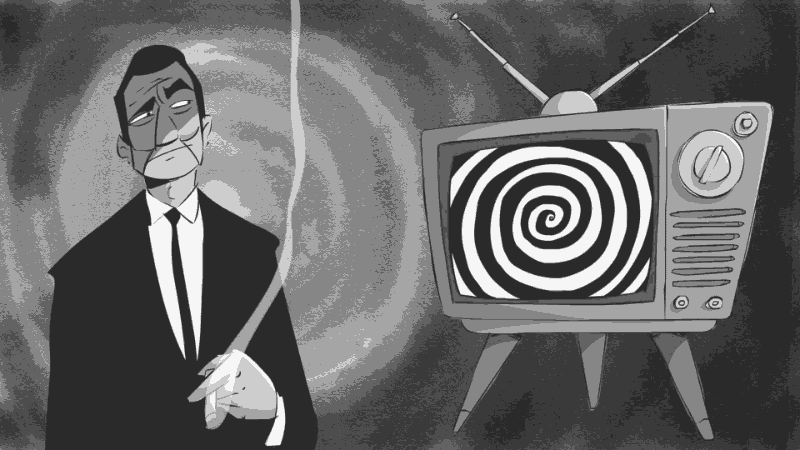
++++++++++++++++++++++++++++++++++++++
"ON THE BEACH" trailer (1959);
The first major Hollywood production to deal with the nuclear apocalypse was based on a novel by Nevile Shute and directed by Stanley Kramer starring big names Gregory Peck, Ava Gardner, Tony Perkins and Fred Astaire. The story starts after a massive nuclear war exchange has wiped out most of the world's population except for Australia where the survivors have learned that a huge radioactive cloud is on its way that will finish off the survivors in a few months. While waiting they go through the motions of life while coming to grips with impending extinction. Peck plays the Commander of an American nuclear submarine docked in Melbourne sent out to return to America to measure radiation levels and find out the source of an unknown random morse code signal coming from San Francisco. Gardner plays a single woman who falls for Peck whose wife and child have already died in America. Perkins is an Australian naval officer with a wife and infant daughter while Astaire is a nuclear scientist. Both are assigned to join Peck's submarine mission to America. Returning to a deserted San Francisco they discover that radiation levels are actually rising and will reach Australia sooner while the mystery morse code signal turns out to be a transmitter key accidentally caught on a window shade chord by the wind thus setting out random signals. One of the crew members deserts and decides to stay to die in America when the sub leaves.
Returning to Australia the characters adjust to their impending fate. With little fuel the only cars are official vehicles while the rest of the population use bikes or horsepower. Nevertheless enough fuel has been stockpiled to allow for a final Grand Prix car race which Astaire enters and wins while several other drivers, with nothing to lose, drive recklessly causing several flaming car wrecks. Peck and Gardner begin an affair while Perkin's wife sinks into a depression. Eventually the radiation cloud moves in and people begin to get sick. Some people throw drunken parties while Christians hold a mass service. Most of the population line up to accept suicide pills issued by the government. Perkins and his wife poison themselves while Astaire locks himself in his garage with his race car and runs the engine, dying by carbon monoxide poisoning. Peck's crew votes to return to America to die and he agrees to go with them. Gardner stays behind watching the sub leave. The final scenes show Melbourne's deserted windswept streets and a banner left over from the Christian rally warning people there is still time to repent. Finis.
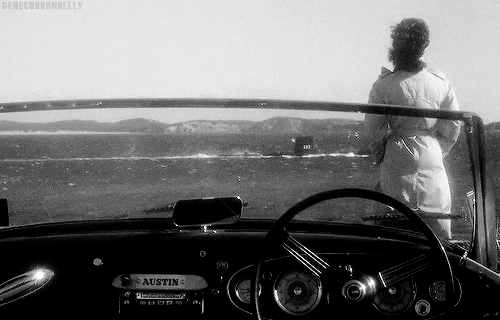
Unlike the previous films (setting aside "Five") where the government authorities have taken preventative measures and at least some of those who have also made preparations and follow government directives can survive, here none of that matters. The government continues to function with well-meaning efficiency right up to the end and society does not break down yet literally everybody dies anyway. The film is entirely hopeless. This rejection of the official Cold War line of "Be Prepared" meant that unlike the previous efforts (again setting aside "Five") this film would not receive any assistance from the US government or military. Luckily the novel was high profile enough (as was director Shute) that the Australian government was prepared to sign up especially since Kramer was prepared to make the journey to Australia to film on location, fairly rare practice for those days, and Australia (which was not a nuclear power anyway) doesn't come off badly in the film. They also helped get the British Royal Navy on board as well to loan out a submarine which helps with the film's realism. The lead cast however are all Americans and only one, Astaire, bothers to even try to wrap his mouth around a vaguely kinda Australian accent, which probably just as well. Peck is excused as his character is American anyway.

Since in this story the nuclear war took place elsewhere there is no need to show any bombed-out rubble but even when the sub goes to San Francisco the empty city is a pristine ghost town. However the shots of the starkly empty city and the later shots of an equally barren Melbourne with paper blowing through the empty streets are undeniably eerie. The focus of the story is more on the romantic subplot between Gregory Peck and Ava Gardner which is quite conventional and suffers from Peck's usual stolid performance. Peck is believable as a sub commander but his noble but wooden persona has no chemistry leaving Ava Gardner who has to lean into her depressed and lonely persona to carry the relationship which given the cloud of impending doom is acceptable enough but it does drag on. Fred Astaire was fine as the cynical, boozy but decent scientist (he certainly does a better job than Gene Kelly did when Kramer gave him the same basic role in "Inherit The Wind'') and would lead to a second career as a straight actor for the then aging hoofer but Tony Perkins and Donna Anderson as an Australian Naval officer and his neurotic wife barely registers in roles that could have easily been given to Australian actors. He was presumably cast for name recognition.
There are some good scenes notably at a party with a chorus of drunken Aussies singing a tuneless version of "Waltzing Matilda" (the unofficial national anthem) which repeats beyond the point of annoyance but then morphs into a nice romantic version as Peck and Gardner kiss. Fred Astaire's car race combines some laughably bad rear screen projection that's right out of the sixties with some realistic fiery car crashes and his death scene has power. Having the streets filled with horses and bicycles due to a fuel shortage is a nice touch. The movie made a few changes to the novel which some critics said were actually an improvement including adding or fleshing out a few characters including an Australian Admiral and his female aide and the final scene was slightly changed. In the novel Peck takes his sub out to scuttle it while Ava takes one of the suicide capsules. In the film version the sub crew votes to return home to die while Ava stands on shore watching them leave, then the scene fast forwards to scenes of the deserted streets of Melbourne. This was a stronger ending although I would have preferred to have the camera pull back from Ava watching the sub leave to reveal a one of the suicide pill packets issued by the government on the car dashboard. I also would have prefered that final shot of the empty streets with the banner reading "There Is Still Time '' not use the bombastic fanfare and instead go for dead silence aside from the sounds of wind and rustling paper. Still having an ending which has literally everybody die is oddly more satisfying than the grit-your-teeth and everything will eventually work out ending of most apocalypse films. One additional note; While the premise of the story is that Australia is the last country to be hit by the radiation cloud due to its being the the southernmost country, New Zealand is of course even further south and should thus have the last survivors yet it doesn't even rate a mention probably because author Nevil Shute (1899-1960) while originally British had long ago moved to Australia by that point.
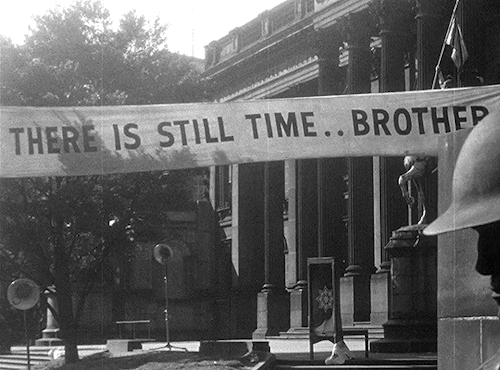
++++++++++++++++++++++++++++++++++++++++
"THE FINAL WAR; 48 HOURS OF TERROR" AKA "WORLD WAR III BREAKS OUT" (1960);
It's fitting that the Japanese would make a post nuclear holocaust film and that it would be the darkest and the most fatalistic. This film is largely unknown outside Japan and given its bleak tone that's not a surprise. At a time when Japanese post atomic films were known for their giant fire breathing dinosaurs this one was not likely to become a cult classic. This nuclear war actually does not even really involve Japan directly and is between the USA and the USSR with Japan caught in the middle. At one point the Soviets announce they will be nuking Japan with the same sort of unctious combination of wounded petulance and self-righteous bullying they still use today in justifying their invasion of Ukraine. Unlike in previous films where the authorities are reasonably prepared (aside from "Five" where they are not mentioned) and most people do not panic, here the authorities are helpless and pretty much everybody panics. People flee the city, doctors and nurses abandon their patients, people are shoved out of the way or run down and nobody stops to help, children are left behind and people kill themselves. Before the bomb is even dropped society is already melting down.
Previous entries had people die of course, in their millions in fact, but it was always safely off-screen. As a partial exception "Five" did show skeletons littering the streets but skeletons have been an acceptable (even comedic) screen presence since the dawn of film. This film shows bodies, dozens of charred, bloated, blackened bodies discarded in the debris. Lest anybody forget that the Japanese do have the right to be so gory in their presentation of nuclear holocaust the movie opens with a scientist giving a lecture about the effects of Hiroshima and Nagasaki with several graphic photos no American film would have shown. It does it again later on as well. In the end pretty much everybody dies, including those who flee the city, and there are no plucky survivors. The film ends with a radio message from Argentina mentioning that the Southern Hemisphere has survived but after what we learned in "On The Beach" they may not last much longer either and even that slightly hopeful message may be in vain.
+++++++++++++++++++++++++++++++++++++++++
"PANIC IN YEAR ZERO" (1962);
This film returned to the idea set out by "Five" to send characters out of the city turning them essentially into castaways. This premise allows the audience to identify with the characters and their plight as something that could potentially happen to them and would be survivable for those who are level-headed, resourceful and ruthless enough to possibly keep their heads, unlike the grim hopelessness of "On The Beach" or "The Final War". This incidentally also allows the filmmakers to shoot on smaller budgets without having to figure out how to film the actual mass destruction or have a huge cast. For this story a typical family including a Los Angeles father (Ray Milland), wife (Jean Hagen), teenage son (Frankie Avalon) and daughter (Mary Mitchell) heading out for a vacation camping and fishing. On the road outside of town with their trailer they see a giant mushroom cloud revealing World War 3 has started and L.A. is gone. They continue on into the hills of Southern California where they hole up in a conveniently clean and spacious cave. Father Milland takes charge to protect his family with grim determination, quickly showing resourcefulness and even ruthlessness. It's almost as if he was expecting this and is fully prepared. The father is grim and humourless as he stockpiles supplies, buys guns, eventually resorting to non-lethal violence. The women folk (naturally) are somewhat skeptical of all this, occasionally wondering if they are going to descend into barbarism. Milland dismisses and to be fair while he does sometimes use violence to for example get guns from a reluctant hardware store or gas from a price-gouging gas station owner, he still insists on leaving an appropriate amount of money. When the family is accosted by a trio of thugs on the highway and the son is forced to shoot one the father makes sure the wound is not serious and rebukes his son for being too enthusiastic over the shooting. He insists on maintaining civilized appearances with regular cleaning and shaves. That trio of thugs will challenge that ballance when they return and are revealed to be more than mere juvenile delinquents when they reappear to rape and murder another couple and attack the daughter leading the father and son to track them down to a farm house and murder them in cold blood. At the farmhouse they rescue a young woman and take her back to their hideout as the father relents on his siege mentality. In the end the state of emergency is lifted after several week and the family will be returning home.
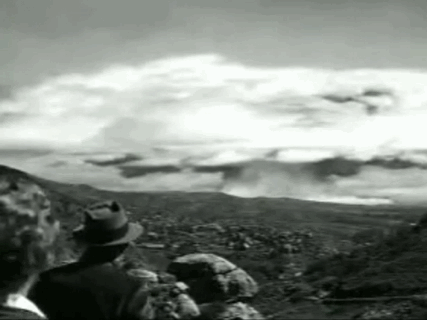
Ray Milland would probably not be given such a lead role today, being too obviously middle-aged, paunchy, balding and average looking to be an action hero in today's films but this makes him more believable. The Welsh born Milland was in fact a WW1 combat veteran who also previously starred as Bulldog Drummond is a series of hardbitten detective films as well as playing the cold blooded killer in Hitchcock's "Dial M For Murder" so he was also believable the he becomes a take-charge and even gun-toting hard man. The film gets down to business within minutes and we never really learn very much about his or the family's prior life; What was his job? Was he always this cold and distant? It would be nice to know. Milland himself directed and while it was his third directing job producer Sam Arkoff (known for shooting with limited budgets and short shooting schedules) later claimed that Milland had been "overwhelmed" and had forgotten some scenes in the rush to finish so perhaps there were some earlier background scenes that got lost in the shuffle. Milland's direction is no-nonsense and efficient and there are no really spectacular shots of empty streets unlike "The World, The Flesh & The Devil" or "On The Beach" since the whole film takes place in a rural and small town area with the town looking suspiciously like the western backdrop it undoubtedly was, but there are no slow parts either as the story starts quickly and stays on point.
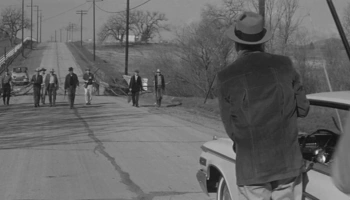
Unlike a lot of Arkoff movies this one had a fairly top flight cast. Milland had an extensive filmography going back to the start of sound films including an Oscar and Golden Globes win for 1945's "Lost Weekend". Jean Hagen, a three time Emmy winner from the TV sitcom "Make Room For Daddy" who is similarly believable and not glamorous (compared to Inger Stevens) as the mother. Teen Idol Frankie Avalon as the son was added for his marquee value and was not known as a serious actor but is acceptable enough. Daughter was played by Mary Mitchell who had a few other minor film credits including the early Francis Ford Coppola B-Movie "Dementia 13". Thereafter she would retire from acting but would continue to work behind the camera in various Coppala films. The rest of the cast were low key but realistic although the three thugs who menace the family do spout some cliche 50's Beatnik slang which hasn't dated well.
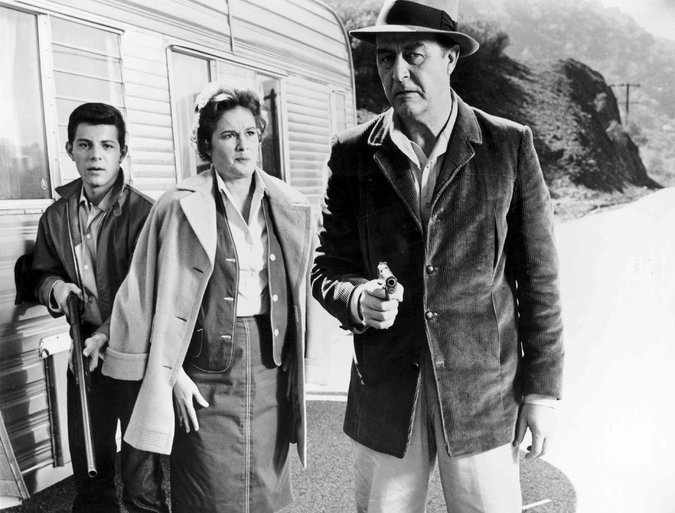
FRANKIE AVALON, JEAN HAGEN & RAY MILLAND
The film takes a harsher look at societal breakdown than most of the other films of the era with many people quickly panicking, turning to looting or worse while the authorities are notably absent until the end. In order to survive, the family takes the law in their own hands instead of the stiff-upper-lip cooperation of most of the previous films. Eventually however the government does reassert itself apparently none-the-worse for wear as soldiers arrive and we are assured that the war was won and the cities will be rebuilt (this time there is no talk of lingering radiation) and we assume the family will live happily ever after.
++++++++++++++++++++++++++++++++++++++
"THIS IS NOT A TEST" (1962);
As we have seen, Post Apocalypse films can be done on a limited budget but it would be hard to come up with a more bare-bones film than this. Somewhere on the highway at night in the Arizona desert a highway patrolman is told that a nuclear attack is pending and he needs to roadblock to stop people from driving to the city. A few cars and a semi truck show up. People who stop include a few couples, a truck driver, and old man and his daughter, and a fugitive killer on the run. It is revealed that the war has started and there has been an alert about an incoming missile. The cop takes charge and gets the idea to take shelter in the truck, emptying out the cargo. While waiting one married woman leaves her husband and starts an affair with the trucker and the fugitive tries to make a run for it. The husband shoots himself. A couple of the locals remember there is an abandoned mine shaft nearby and decide to run there for shelter. Before the bomb even drops people turn on each other as the cop kills a pet dog. Another group of looters fleeing the city shows up and beats up the cop with some taking his car while others lock themselves in the truck while the radio reports the missiles are about to strike. In the end the cop is left outside with the killer (who has returned) begging to be let in as the missiles hit. The movie ends without knowing their fate but is assumed that everybody dies with the possible exception of the couple who fled to the mines assuming they had enough time to get there which seems doubtful.
One of the most odd things about this film is that it's impossible to know if it intends to subvert the other films in this genre but it does. In previous films authority figures (the government, police, military, doctors) are usually efficient, conscientious and all knowing, but here the authority figure, the cop, is not only an arrogant stiff-necked martinet, he's also totally wrong. Even the largest semi trucks can be blown aside by gale force winds to say nothing of the radiation fallout so the truck is clearly not strong enough to serve as a shelter and is little better than a deathtrap. The plan to hide out in the mine shaft is the only one that has a chance of success. Still the cop is completely unreasonable, relying on force to assert his authority and refusing to listen to any other opinions and even though he objectively doesn't know any more than anybody else he assumes that since he has a badge and a gun he is qualified to make all decisions and everybody basically complies albeit with some grumbling. A couple people sense that he's wrong but nobody seriously challenges his assumed power to make all decisions until the end. Instead of representing an efficient, prepared authority he is a distant unreasonable force who can not be questioned assuming dictatorial powers. Unlike the stiff upper-lip stocism of earlier films here everybody panics and are at each other's throat before the bombs even drop. We are even told the nearest cities immediately erupt in rioting and looting. Authorities are either distant (via the radio) and unhelpful or randomly dictatorial and ignorant (the cop). There is a certain grim satisfaction in watching the stiff-necked bullying cop breaking down in the end and begging to be let into the truck, not that it would make a difference.

The actual filming of this film is beyond B-Movie basic. The only set is a short stretch of highway and surrounding scrubland with a few cars and trucks. Note that while the flim references California a few times the county listed on the police car door is in Arizona so they must be on the border. The cast counts about a dozen including extras. The entire film takes over a single night so the whole film is shot in darkness except for one brief shot at the end when it suddenly switches to daylight suggesting they may have been shooting in day for light and missed a shot. There is little need for music although that is probably for the best considering the bombastic fanfare they probably would have used. The cast are largely no names and would stay that way and as with "Panic in Year Zero" one of characters talks with dated 50's Beatnik slang. Seamon Glass who plays the cop is duly wooden but that might actually suit his dumbly overcompensating small town cop. He would have more minor screen credits including a bit part in "Deliverance". The one actor here with a real resume is Carol Kent which is actually the pseudonym for actress Marie Windsor who plays the blonde cheating wife. Windsor had a long career starting as a joke writer for Jack Benny who encouraged her to try acting. Starring mostly in B-Movies and Film Noirs from the 1940's to end of the 1980's including the Stanley Kubrick's "The Killing" (where she plays Elisha Cook's shrewish wife), "Force Of Evil" (with John Garfield), "Narrow Margin", "The City That Never Sleeps" and "Cat Woman Of The Moon". She died in 2000 the day before her 81st birthday and she has a star on Hollywood Blvd.

+++++++++++++++++++++++++++++++++++++
"LADYBUG LADYBUG" (1963);
This quiet little film is focused on a small elementary school in a rural area which has its emergency alert system send out a warning of an impending attack. Being unable to ascertain whether or not the alert is real the Principal (William Daniels) decides to send the kids home. Some of the kids have to walk home escorted by a teacher. Much of the film is taken up by conversations between various kids as well as the teachers with the kids talking about war and the bomb. Once at home some kids and their parents react in various ways with some hiding in their basement, others praying and others trying to convince their parents that the alert is real. One group takes shelter which leads to infighting about food and water and allowing in other kids in a plotline inspired both by "Twilight Zone" and "Lord Of The Flies". The ending is heavy on symbolism and packs a huge emotional punch with one (probable) death seeming more devastating than the deaths of millions in some previous films. The film is shot in a low key verite style with no music or special effects which only adds to its power. The plot is advertised as being based on real events but it's unclear how true that is at this point. Note the cast of then no-names includes the first film roles for future Oscar winner Estelle Parsons ("Bonnie & Clyde") and future multi Emmy winner William Daniels ("St Elsewhere"). Kathryn Hayes, who plays the pretty secretary, would go on to a long soap opera career and just died this past March. Most of the kids did not go on to professional film careers.
+++++++++++++++++++++++++++++++++++++++
"THE WAR GAME" (1966);
Previous post apocalypse films have either treated the subject in a fairly detached and antiseptic fashion or used it as a setting for other stories and were in the end treating the subject for entertainment, thoughtful entertainment at times, but entertainment none-the-less with the exceptions of the grim episode of "The Medic" and the documentary styled "A Day Called X" and "Target Austin". That is not the case here. This film can not be considered entertaining nor was it meant to be. This film was meant to horrify people. Not in the fun, cathartic way that horror films do, but to scare the audience into awareness and political action and to critique the governments of Britain and the US in direct ways that no previous film would have dared to. This British film is set in a not too distant future when a nuclear war breaks out and missiles strike Britain. Shot in the style of a news documentary it does not have any central characters instead ranging from various man-on-the-street interviews and footage in the small Northern city of Kent along with some talking head experts as well having an offscreen narrator. At the beginning we are shown various people attempting to follow the government's instructions to build shelters and stock food but it is clear that these measures will be woefully inadequate. There are shortages and price gouging but more confusion and annoyance than panic. At least not yet.
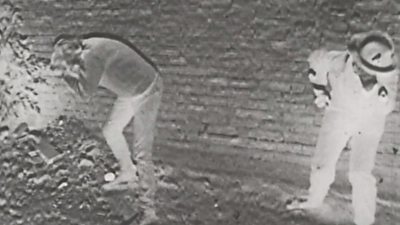
Naturally things worsen with a build-up to war which starts with a Chinese invasion of South Vietnam followed by a US threat to use tactical nukes which is followed by a Soviet attack on West Berlin which leads to trapped Allied forces using tactical nukes followed by the USSR launching missiles at Britain and a counter strike. When the strike comes it is not a distant explosion and mushroom cloud but we are instead given an extended on location view of a shattering blast which reduces blocks to rubble and blinds many people followed by a howling firestorm which kills through both fire and suffocation. Neither firemen and police or civilians, adults or children are spared painful on camera deaths. Even once the fires are brought under control radiation burns and poisoning are rampant. Medical staff are overwhelmed by the flood of injured and dying with many too far gone to be helped being instead simply shot in the head. Inevitably rioting breaks out over food shortages with rioters and police being killed. Eventually some rioters are summarily executed. The end of the film occurs at Christmas as shell shocked children huddle listening to a warped record of "Silent Night" plays on a broken record player. Asked what they want to be when they grow up they mutter "Nothing at all".
Previously the episode from "The Medic" had been the most grim, "One The Beach" had been hopeless and the Japanese film "The Final War" and "Ladybug Ladybug" had shown anger but "The War Game" went further showing real rage at the suicidal destruction and goverment stupidity and arrogance. Throughout the film various talking heads representing figures from government and religion give smug assurances about the winnability and morality of war including one religious leader who advises not allowing neighbours to share your shelter (one man shows off his shotgun he has stored for this reason) and an American official who pompously states that after a pause to rearm and plan they can safely fight "World Wars Four through Eight". Note all the official statements made in the film were taken from direct quotes of actual American and British leaders and officials. There is not even the sort of cheery "Spirit Of the Blitz '' muddle-through attitude normally considered typically British. Instead when at the start of the film as women and children are moved out of the larger cities to smaller ones like Kent to be billetted with local families (eight members at a time) that are met with resentment. One man tries to refuse (to be threatened with arrest) while another insists he won't take any "coloureds". Compare this to the stiff-upper-lip muddle through attitude when such billeting happens in the 1954 TV show "Atomic Attack" where after some perfunctory arguments everybody pitches in and works together. There is anger, violence and murder and eventually numb, shocked hoplessness. When people are informed that NATO missiles have struck Russia in response nobody cares. "As if that matters" says one woman.
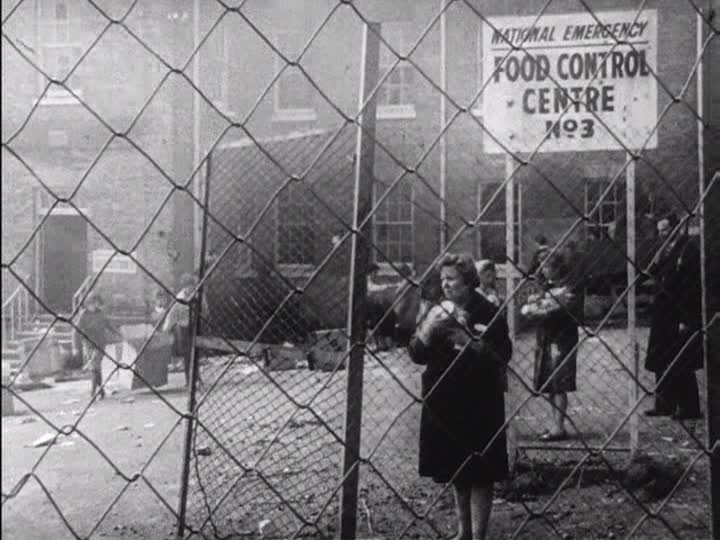
As shot in Cinema Verite style the film is immediate and kinetic with a "you are there" immediacy of a news cast having various characters directly addressing the camera and answering an oddly unseen interviewer. There is also a grim voiced off-screen narrator coldly reading off statistics which are also shown onscreen with occasional maps and graphs to illustrate points and repeatedly remind us that this is what nuclear war would be like. While most previous films showed their casts clean and wearing neatly pressed clothes, here everybody is filthy, sweaty, unshaven and utterly exhausted with visible fresh wounds and hollow eyes. There are no fantasies about a hero holing up with his family and a gun and emerging to take charge. Here society has not completely broken down, the government continues to function, however ineffectively, but millions are dead, the cities are in ruins and it is clear that it will take decades to rebuild any sort of civil society at all. By contrast even the ending of "On The Beach" where literally everybody dies, is almost upbeat by comparison as it is at least a clean ending with little suffering and everybody still looks great. This film may not have a big budget with many shots suspiciously cropped suggesting small sets and less extras than appears at first glance. There are no recognizable actors and no soundtrack which would have detracted from the verite feel and relentless angry gloom.
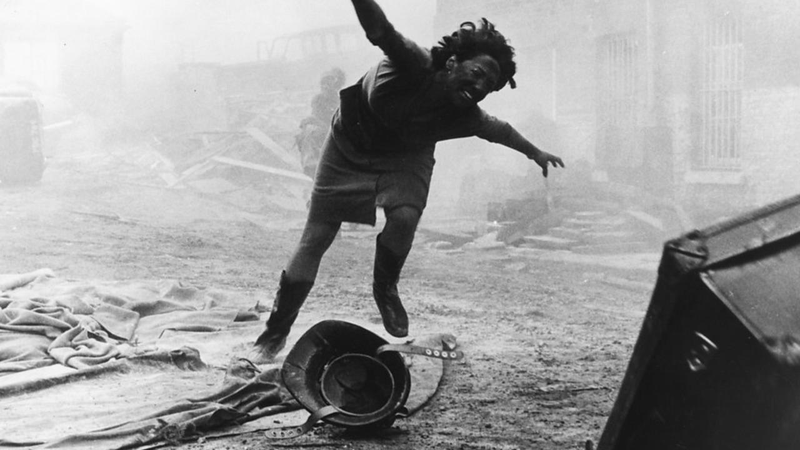
Made by for the BBC by documentary filmmaker Peter Watkins who had previously done a well regarded similarly gritty verite doc about the 1745 Battle Of Culloden (ie the final defeat of the Scottish Highlander army of Bonnie Prince Charlie) the previous year but this time the BBC and British government were horrified by the results. Note that besides the graphic portrayal of war itself the film also rages at the governments of Britain and America. Unlike in the reassuring government sanctioned films "Atomic Attack", "A Day Called X", "Target Austin" and even the darker "Medic" episode" where government preparations were fairly effective here they are shown to be woefully inept, incomplete, outdated and slapdash and given the lack of warning time people would actually get, pathetically inadequate anyway. These themes would reappear in the later British made "Threads" and "When The Wind Blows" in the eighties. This is combined with the clueless belligerent displayed by the collection of talking heads representing the government. Incidentally while previous films had either placed the blame on the Soviets for starting a nuclear war here it is clearly NATO who strike first and the jaw-droppingly arrogant comments from various talking heads make it clear that some of our leaders would be perfectly prepared, even blase about doing so. The film was banned from the airwaves although it did play as a theatrical feature in some festivals and won an Oscar in 1967. There would also be a paperback version. It would then make it's way to America for a festival screening in 1968 but was also banned from TV. It did not appear on UK TV until 1985 the day before the broadcast of the similar British nuclear film "Threads" which has many very similar scenes and general look minus the voiceover. The film has been called a masterpiece by many critics including Roger Ebert and judged one of the top hundred documentaries of all time. Even today it is second only to the slightly more graphic "Threads" as the most disturbing post nuclear film ever and easily surpasses the more high profile and bigger budget American TV movies "The Day After" and the quieter, heartfelt "Testament".

+++++++++++++++++++++++++++++++++++++++
At the start of the Cold War post nuclear films, while always accepting that mass casualties were inevitable, also insisted that with enough preparation, resourcefulness, pluck and luck, some people would survive none-the-worse for wear and society would rebuild. Films like "The Five", "Atomic Attack", "The World, The Flesh & The Devil" and "Panic In Year Zero" are essentially castaway movies using nuclear war as a setting but not really addressing the larger issues. "A Day Called X" and "Target Austin" are meant to reassure the viewer that plans and preparation were indeed being done and government officials were firmly in control of the problem. We should be prepared but no need to worry. The one exception is the episode of the TV series "The Medic". With "On The Beach" attitudes had changed, in that film and the entire population was wiped out albeit in a nice clean style. By that time the Red Scare had waned and it was safer to question the official narratives about war and nuclear weapons. Later films, from the bitter Japanese "The Final War" to the more artistically tragic "Ladybug Ladybug" to even the low budget "This Is Not A Test" are openly angry and scornful of official authorities and the pointless stupidity of war. By the time we get to "The War Game" we have a rasping scream of pure rage.
THE RENEGADES ~ "13 WOMEN";
